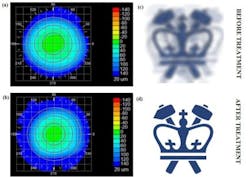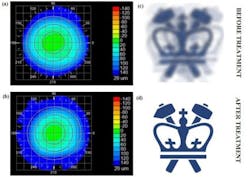Ultrafast laser technique for vision correction is noninvasive
Knowing that laser-assisted vision correction surgeries such as laser in situ keratomileusis (LASIK) and photorefractive keratectomy (PRK) can thin and in some cases weaken the cornea, researchers at Columbia Engineering (New York, NY) developed a noninvasive ultrafast laser approach to permanently correct vision that shows great promise in preclinical models. The work could lead to treatment for myopia, hyperopia, astigmatism, and irregular astigmatism.
Related: 'Especially gentle' ultrafast laser treatment targets presbyopia
Led by Columbia Engineering Lecturer in Discipline Sinisa Vukelic, the work uses a femtosecond oscillator (which delivers pulses of very low energy at high repetition rate) for selective and localized alteration of the biochemical and biomechanical properties of corneal tissue. The technique, which changes the tissue's macroscopic geometry, is nonsurgical and has fewer side effects and limitations than those seen in refractive surgeries. For instance, patients with thin corneas, dry eyes, and other abnormalities cannot undergo refractive surgery.
The femtosecond oscillator alters the biochemical and biomechanical properties of collagenous tissue without causing cellular damage and tissue disruption. The technique allows for enough power to induce a low-density plasma within the set focal volume, but does not convey enough energy to cause damage to the tissue within the treatment region.
The critical component to the approach is that the induction of low-density plasma causes ionization of water molecules within the cornea. This ionization creates a reactive oxygen species (a type of unstable molecule that contains oxygen and that easily reacts with other molecules in a cell), which in turn interacts with the collagen fibrils to form chemical bonds, or crosslinks. The selective introduction of these crosslinks induces changes in the mechanical properties of the treated corneal tissue.
Corneal topography before and after the treatment, paired with virtual vision that simulates effects of induced refractive power change. (Image credit: Sinisa Vukelic/Columbia Engineering)
When the technique is applied to corneal tissue, the crosslinking alters the collagen properties in the treated regions, and this ultimately results in changes in the overall macrostructure of the cornea. The treatment ionizes the target molecules within the cornea while avoiding optical breakdown of the corneal tissue. Because the process is photochemical, it does not disrupt tissue and the induced changes remain stable.
"If we carefully tailor these changes, we can adjust the corneal curvature and thus change the refractive power of the eye," Vukelic says. "This is a fundamental departure from the mainstream ultrafast laser treatment that is currently applied in both research and clinical settings and relies on the optical breakdown of the target materials and subsequent cavitation bubble formation."
Vukelic's group is currently building a clinical prototype and plans to start clinical trials by the end of the year. He is also looking to develop a way to predict corneal behavior as a function of laser irradiation, how the cornea might deform if a small circle or an ellipse, for example, were treated. If researchers know how the cornea will behave, they will be able to personalize the treatment—they could scan a patient's cornea and then use Vukelic's algorithm to make patient-specific changes to improve his/her vision.
Full details of the work appear in the journal Nature Photonics.

